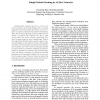Free Online Productivity Tools
i2Speak
i2Symbol
i2OCR
iTex2Img
iWeb2Print
iWeb2Shot
i2Type
iPdf2Split
iPdf2Merge
i2Bopomofo
i2Arabic
i2Style
i2Image
i2PDF
iLatex2Rtf
Sci2ools
ICNP
2005
IEEE
2005
IEEE
Simple Robotic Routing in Ad Hoc Networks
Position-based routing protocols in ad hoc networks combine a forwarding strategy with a recovery algorithm. The former fails when there are void regions or physical obstacles that prevent transmission. Then, the recovery algorithm is used to detour the obstacles. To explore the obstacles and find a path around them, the earlier recovery approaches construct a planar graph to avoid routing loops. Distributed algorithms that find planar graphs require accurate knowledge on the location of nodes. The number of nodes on a recovery path increases as the node density increases. Our novel recovery technique operates on a grid model of a network. Obstacles are approximated by adjacent grid elements. We adopt the righthand rule, which is common in robotics, to follow the perimeter of the discretized obstacle. We do not construct a planar graph. The grid structure reduces the positional accuracy required for nodes, and the recovery path length is independent of the node density.
| Added | 25 Jun 2010 |
| Updated | 25 Jun 2010 |
| Type | Conference |
| Year | 2005 |
| Where | ICNP |
| Authors | Daejoong Kim, Nicholas F. Maxemchuk |
Comments (0)

